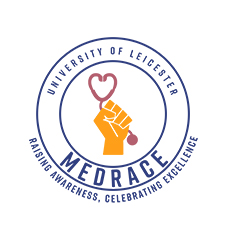College of Life Sciences
Complementing awareness with action: a collaborative effort for change in medicine
Ololade Tijani, Student, Leicester Medical School
The importance of inclusivity in medicine cannot be overemphasised and is increasingly acknowledged by individuals (medical students) and organisations (medical schools). Due to this, a plethora of attempts to mend identified gaps have been implemented and are still currently being implemented. Yet, we can’t truly mend the problematic gaps without minding or being aware of the gap. In our active bystander training that we get as medical students in our pre-clinical and clinical induction, the first step in being an active bystander is to notice. Although this may appear a seemingly basic concept, the practical element may be much more challenging than you would think. How do you notice what doesn't apply to you especially when you've not heard anyone around you mention something about it? I certainly didn't notice or think my hair could pose any challenges to my experience in medical training (at least not in the early stages as an aspiring medic).
The issue
As I was tapping through Instagram stories, one post highlighted potential issues that could be faced from a patient perspective. This post featured an admirable hairstyle which would not impede clinical practice in anyway (needless to say); however, the post said, a patient made a comment referring to this medical student as 'scary spice' alluding to their feelings towards the volume of her natural hair. I was concerned about the prevalence of incidents such as this as well as what perceptions were being upheld regarding natural hair within the medical/healthcare setting.
With nowhere near the same volume of hair (although I would love to), I didn’t realise my hair would impact my experience in clinical environments such as in theatres. We had been given a timetable for our surgical placement so I had an idea what to expect and was planning to schedule times when I would attend theatres; planning to adapt my hair to fit into the scrub caps. However, after our ward round, the consultant asked if we would like to go to theatre; an offer which I was very ecstatic about considering the fact that I had never been in one before (evidently not motivated by the opportunity to wear scrubs and look like a surgeon). Thus, not thinking about my hair I bounced off to theatre looking forward to maximising this opportunity. I was ready to go and after changing everything else, all I needed was just put on my scrub hat and go - at least that's what I thought. Shockingly, what started with a huge smile ended with me having netty knickers on my head as that was the only thing they could find to fit my hair. Thus, making my first theatre experience a very different one to what I had anticipated. Moments later, another theatre practitioner saw what was given to me as a hair covering and gave me a larger scrub hat that which I did not have access to on my next theatre visits.
Raising awareness
The fact that this affected my theatre attendance made me realise certain practices within the healthcare setting such as this have an adverse impact on the education we receive and should be addressed on a larger scale. Thankfully, I was able to raise my concerns with the MedRACE group (previously BMA Racial Harassment Charter Working Group. Having mentioned this, our staff leads, Dr Shameq Sayeed and Dr Kate Williams were very supportive and keen to ensure this was not a narrative propagated along our medical education. The staff leads mentioned that they would not have recognised this as an issue if it hadn’t been raised but once it was highlighted, action could be taken. Consequently, they raised this with senior members of the medical school including our head and deputy head of school who were thankfully receptive to the matter and sought to provide a solution. Acknowledging that trustwide change was not going to materialise within a quick time frame, the medical school opted to purchase more inclusive scrub hats for students. We were aware that scrub hats suitable for larger hair volumes existed and having had a conversation with my friend, Hazel Owusu-Yianoma (a 3rd year medic at the University of Liverpool), I shared a picture she sent to me featuring a medical student who was wearing a scrub scarf which enabled her to cover her hair appropriately. This prompted us to contact the student who signposted us to where these inclusive scrub headwear could be obtained. Further discussion on this also resulted in me contacting Olamide Dada, Founder and CEO of Melanin Medics, who signposted us to a company called WarwickMed who were providing inclusive scrub hats. We were able to obtain samples from Medline and WarwickMed.
Taking action
Following this, the samples were made available to students to try on and rank them in order of suitability, providing comments to help ascertain the most appropriate scrub hat to purchase for clinical medical students as shown in the pictures below. We made efforts to ensure that a variety of students were involved in this process to make the chosen scrub headwear representative of the medical school population.
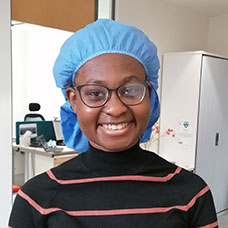
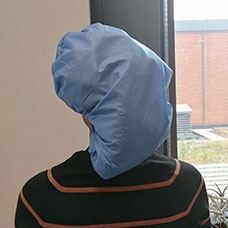
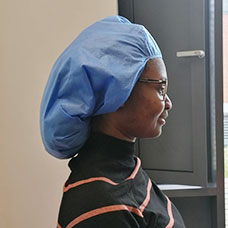
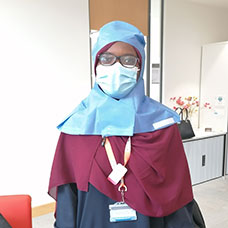
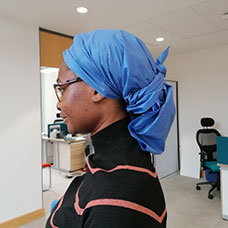
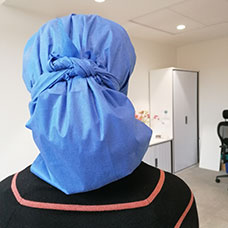
This was a process spanning months which is reflective of change within most environments which tends not to take place instantaneously. The crucial nature of amplifying the voices of those who recognise the need for change and whose experiences indicate necessitation of positive change is additionally emphasised by the resounding theme of people not being privy to this issue prior to it being mentioned within the MedRACE group.
Issues on hair beyond surgical headwear
Just in case you don't know about the MedRACE group, it is a staff-student group through which we have been able to have different discussions to address issues on hair beyond surgical headwear which has also led to the Annual Medical School Agreement and Medical School CoP documents including sections explicitly elucidating the views upheld by the Medical School regarding student and staff hairstyles which was an adaptation of the Halo code. The MedRACE group has also discussed a variety of issues which have led to the development of Student Selected Components (SSC's) on topics such as Decolonising the medical curriculum and Events highlighting excellence in diversity including the Miss Samantha Tross and International Women's Day conferences. Check out the MedRACE group on https://le.ac.uk/cls/cls-equality/medrace which has our social media details too!
Looking forward
Thus, as the medical school works in collaboration with the MedRACE group in providing scrub hats and allaying students' concerns on their hair, I hope this change is widespread and effectuated on a larger scale including local, regional and national level. I would really like to highlight that the aim of this blog is to really encourage us to have an optimistic outlook when it comes to change and be assured that highlighting these issues are not criticisms; instead, it is a chance to truly raise awareness and remove the perhaps unnoticed disparities that can be disadvantageous to people within the healthcare environment. For example, there was the option to buy larger washable headgear but this was opted against as it would have imposed a financial burden on some students and would have been discriminatory due to its imposition affecting only a certain group of students.
To conclude, every voice needs a platform to articulate problems and effect change - otherwise we pose a risk of depriving the most suitable candidates from thriving in areas where they could excel due to fear of additional barriers they may have to overcome. Thank you very much to our staff leads and student contributors for all their hard work in implementing this ongoing positive change.
